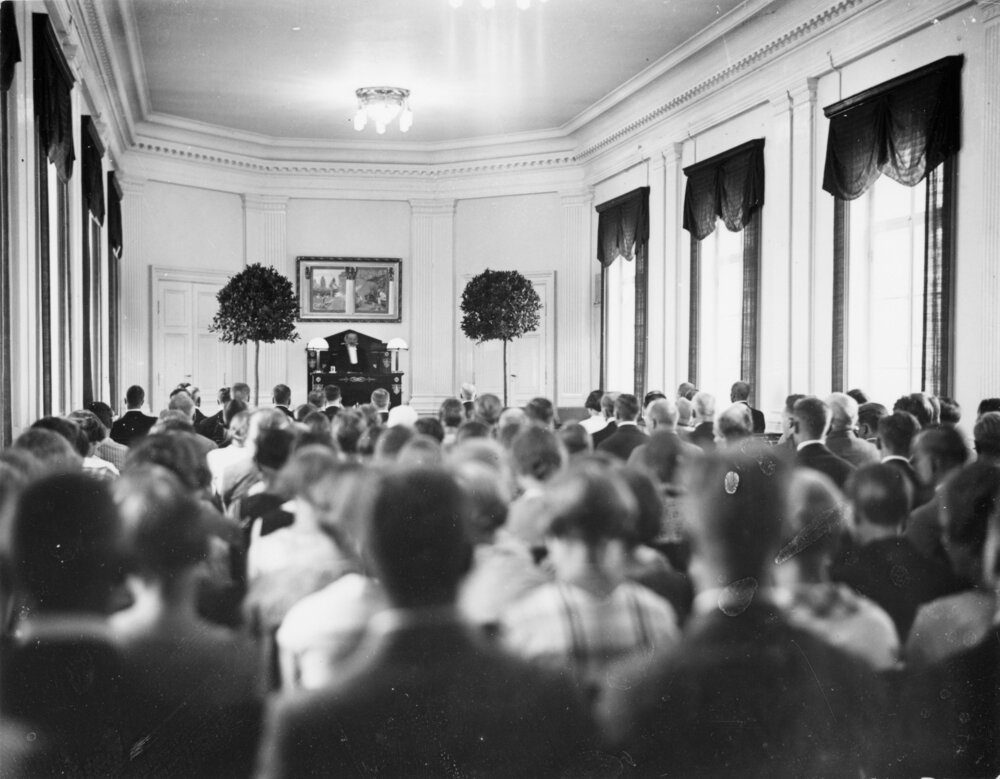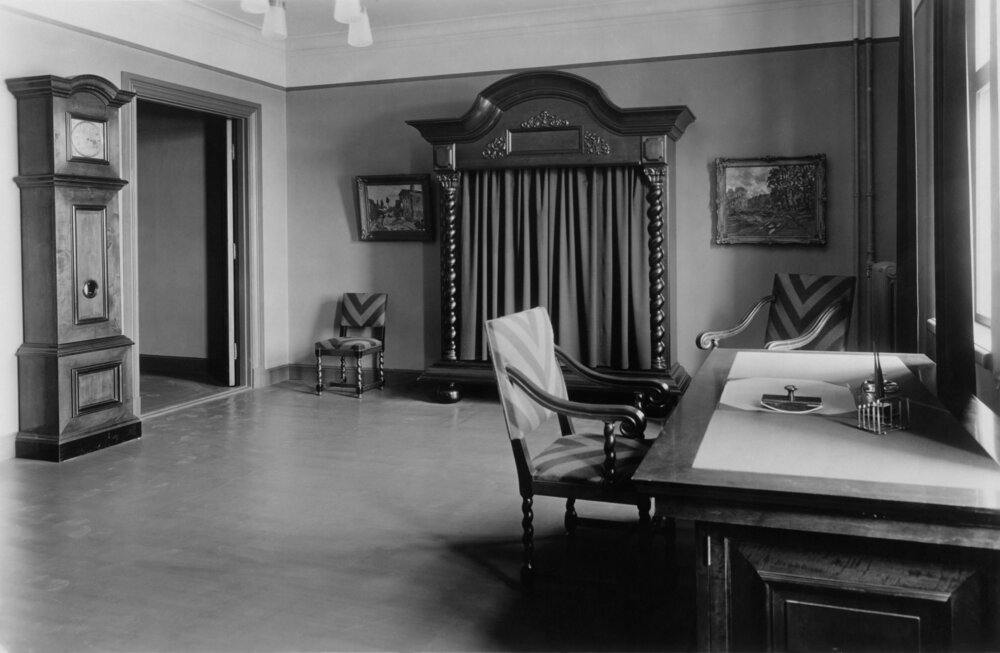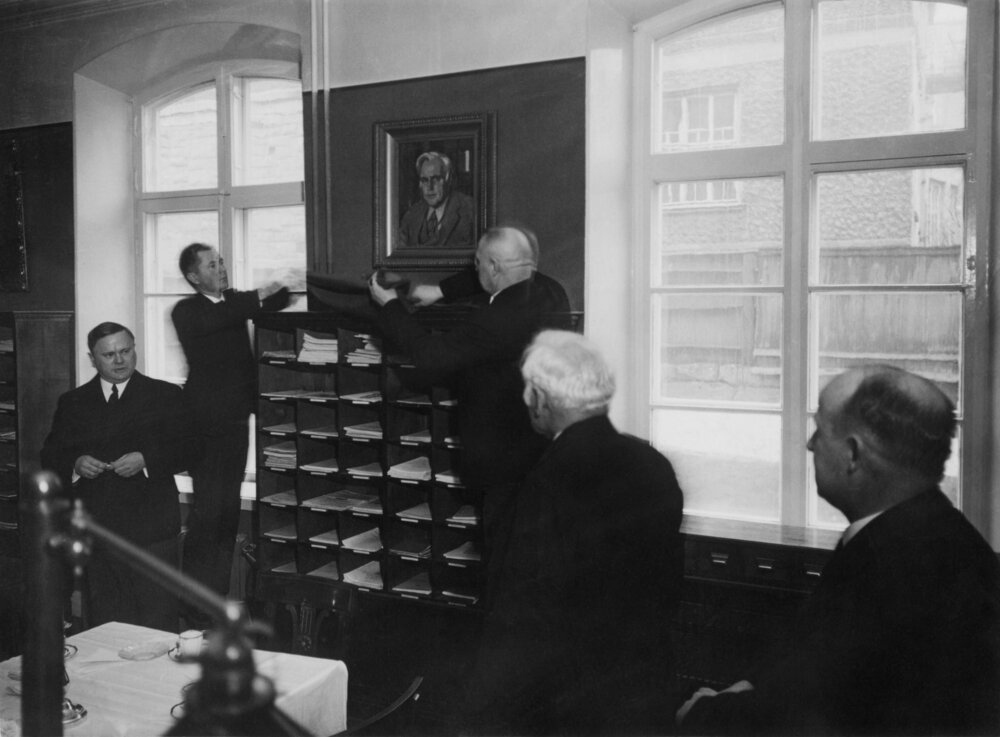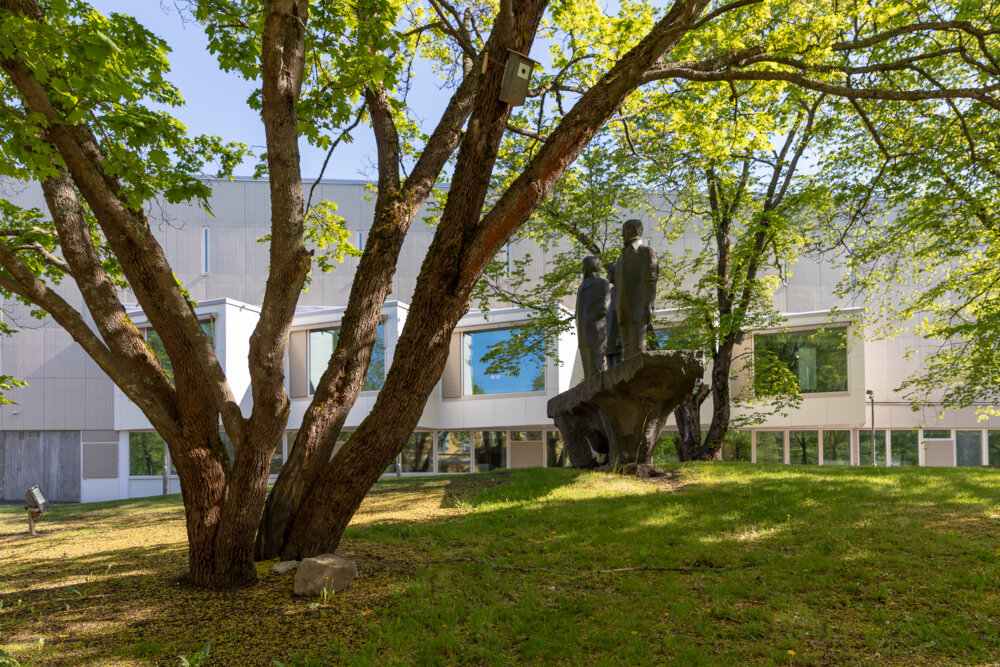History of the art collection
“A group of the most presentable artists of our country has decided to donate to the University of Turku a rare and valuable art collection, which will be compiled so that each participating artist will give one of their most distinguished works to the collection. This way, the Finnish University of Turku will receive, as a gift from Finnish artists, an art collection that represents Finnish art and is preserved at the University as the artists’ contribution to the Finnish population’s grand effort of building the first Finnish-language university in the country.”
“Taidelahjoitus Turun suomalaiselle yliopistolle,” Länsi-Suomi, 3 February 1921

Embellishment of the University’s premises and birth of the art collection
The accumulation of the Finnish University of Turku art collection began in the same way as the establishment of the University in general, but in this case, artists participated in the effort alongside benevolent citizens and communities. Numerous individual artists and private persons made donations to the new privately-owned university that did not receive state funding, and people organised raffles, sales events and festive soirées to raise funds to decorate the premises. Artists both donated their existing pieces and created new ones, for example, painting portraits of the University’s employees and supporters. At the inauguration in 1927, the Finnish University Society of Turku handed over the art collection to the University, along with other property.
On 19 January 1921, a meeting was held in Helsinki with the purpose of embellishing the future premises of the new Finnish-language university. Participants in the meeting included painter Eero Järnefelt and sculptor Emil Wikström, both of whom had already established themselves as nationally recognised artists and were known as supporters of the Fennoman movement. The meeting established a committee, the members of which included painters Pekka Halonen and Eero Snellman, artist and artisan Eric O. W. Ehrström, and architect Armas Lindgren, who was also interested in art and interior design (according to some sources, sculptor Alpo Sailo was also a member). Later in the month, several of the members visited the former Phoenix hotel, which the University Society had purchased as the University’s main building, to see the premises and negotiate with the representatives of the society. The first priority was to decorate the Rector’s office, but the group soon turned their attention to the council meeting room (later administration room), the Chancellor’s room, the auditorium, and, eventually, also to the lecture rooms and other common facilities.
The committee turned to Finnish artists, encouraging them to donate their works to the University. Armas Lindgren promised to make designs for the interiors and furniture of the Rector’s office and Emil Wikström designed a memorial medal, which the University Society struck in two sizes. Most of the revenue from the sales was used for decorating the Rector’s office. The University received numerous donations from artists, especially in 1922–1924. In addition to a few Kalevala motifs and depictions of peasant life, the majority of the donated works were landscapes or official portraits that are an essential part of the academic tradition.

Nationalist key works
Gradually, the public premises of the University, which had opened on 27 June 1922, became home to a small collection of key works thematically linked to the Fennoman movement, such as folk poetry. The place of honour above the podium on the back wall of the auditorium was, in its own right, granted to Akseli Gallen-Kallela’s Lönnrot and Chanters of Kalevala (1913), a large sketch for a mural the artist had made for the Great Hall of the University of Helsinki but not completed due to a polemic in the Swedish-language press about its unacademic subject matter. The defenders argued that the piece depicted collecting information about the past by using modern fieldwork methods. The artist, who had served as an invited member to the first board of the Finnish University Society of Turku since 1917, notified the University of the donation on Kalevala Day, 28 February 1923, but apparently, the painting was not delivered to the University until the beginning of the following year. As a placatory gesture, Gallen-Kallela announced on the same day that he would donate a sketch depicting the inauguration of the Royal Academy of Turku to Åbo Akademi University, the Swedish-language university that had been established in Turku three years earlier.
In 1929, the rear wall of the longitudinal auditorium was adorned with The Power of Song (Väinämöinen Playing the Kantele, 1914), Elias Muukka’s large oil painting donated by the artist and his spouse. Muukka painted the poetic Kalevala-themed painting during his years in Turku. In the triptych sketch, Väinämöinen sits on a cliff by the water, enchanting all creation with his music. The third major Kalevala-themed work is The Light Returns to the North (Loosening of the Sun), a three-panel marble relief commissioned by a group of local women for the University Library from Aarre Aaltonen, a local sculptor. The relief was hung on the rear wall of the reading room in 1924. The artist selected the theme himself, using canto 49 of Kalevala as inspiration for the central panel, which describes the freeing of the sun and the moon from the stone mountain of Pohjola, where Louhi, the Mistress of the North, had captured them. In the low Art Deco relief, smith Ilmarinen admires the released sources of light, accompanied by two young men. The classicising side panels depict allegorical sower and reaper figures. As a whole, the almost 1.5-metre marble triptych was a notable monumental commission in Finland at the time.
It appears that Uuno Eskola’s Prayer Sermon (1923), which the Salo-based artist painted in the spirit of the November Group and which was donated to the University in 1923 by a private donor, was one of the favourites of the contemporaries. The work can be seen hanging on the walls of the committee room or the Chancellor’s room in several photographs taken during the interwar period.
Naturally, the University needed some portraits of important national figures to demonstrate its nationalist mission. Along the years, copies of half-length portraits of J. V. Snellman (Bernhard Reinhold, 1874, University of Helsinki) and J. L. Runeberg (Albert Edelfelt, 1893, Turku Art Museum) found their place on the rear wall of Lecture Hall I in the Phoenix building. The University acquired 17 silhouettes of the builders of Finnish culture and society by Emil Cedercreutz in 1919, already before the University was established. The black cutout silhouettes were hung in oval frames above the bookshelves of the library reading room. Contemporary photographs of the interiors also show portraits of important Finnish figures and plaster casts of a range of ancient artworks, donated by private citizens.

The portrait collection
A major piece among the early portraits is Eero Järnefelt’s donation, which received considerable national attention: the portrait of J. R. Danielson-Kalmari, the University’s first Chancellor, well-known Old Finnish Party member and Councillor of State, which the artist painted as his gift to the new university in its year of inauguration, in 1922. The plain and sturdy portrait appealed to contemporary audiences, and the work was also on display in Järnefelt’s critically acclaimed private exhibition in 1924 in Stockholm. The portrait was hung in the Rector’s office, as planned, and in summer 1923, another portrait donated by the same artist was hung on its left side: Anna Snellman-Kaila’s posthumous portrait of Heikki Ojansuu, Professor of Finnish and Finno-Ugric Languages. Professor Ojansuu had also served as the first Dean of the Faculty of Humanities. Known as a landscape and portrait painter, Snellman-Kaila was the spouse of Eino Kaila, the first Professor of Philosophy at the University.
The portrait of Artturi H. Virkkunen, the first Rector of the University and Professor of Finnish History, was donated by artist Wilho Sjöström in the same year. Another work that also hung in the Rector’s office was Emil Rautala’s donation, the portrait of Aleksis Käpy (1922), Chair of the Turku Finnish University Society Board and President of Turku Court of Appeal. Rautala’s numerous later portraits of the university community, which he painted by commission, have been praised for their nuanced characterisation and rich, even polyphonic colour range.
In spring 1930, another official portrait of Danielson-Kalmari was unveiled at a party of the Student Union of the University of Turku, again painted by Järnefelt; the Chancellor and historian was also the Student Union’s first Honorary Member. He was not the only important figure to have multiple portraits within the university community, acquired on the initiative of different parties. Nationally renowned poet V. A. Koskenniemi, Professor of Finnish and Comparative Literature and the second Rector of the University, was painted twice by Emil Rautala alone: in a portrait commissioned by the Student Union of its Honorary Member in 1935 and in a 60th birthday portrait commissioned by the University Society in 1949. As an influential cultural figure, Koskenniemi is a prime example of the friendship between the artist and the sitter. The University Society funded some of the portraits and, at times, the donor wanted to remain anonymous, but after the first years, the established practice was that friends, acquaintances and colleagues collected money for the 60th birthday portrait of the subject.
The Faculty of Medicine, in particular, has followed this hundred-year-old tradition even after the 1970s, while the portraits of Chancellors and Rectors have typically been commissioned centrally. Most of the works in the University’s art collection are portraits. After Emil Rautala, some of the University’s especially trusted portraitists have been Turku-based artists, such as Liisa Tanner, a member of Koskenniemi’s literary circle, and contemporary artist Kaari Hilkka Könönen. The majority of the portraits are framed oil paintings, with attributes indicative of the sitters profession, but the 100-year-old collection also includes a few works that are more experimental in their use of form and materials.

Women’s importance as donors
The role of women in the birth of the University of Turku, not only as students, but also as donors, was recognised already in the 1920s. In 1928, Toini Melander, who worked as Librarian in the University Library, described in the conservative women’s movement magazine Suomen Nainen (“Woman of Finland”) the great attention paid to interior design when the Phoenix hotel was transformed into the University’s main building: “The aim was not only to create official reception rooms and lecture halls, but also, and above all, cosy and pleasant nooks adorned with works of art, rugs and period furniture that welcome visitors to stop and enjoy the space for a while. We have Finnish women and artists to thank for this achievement, as the University’s most beautiful rooms are the fruit of their collaboration.” Melander was referring, in particular, to the Rector’s office, which was made warmer and cosier through the joint efforts of Finnish women, featuring the large floor rug donated by women from Satakunta, cast-iron lighting fixtures provided by inhabitants of Lahti, and the dark curtains designed by local textile artist Katri Warén-Waris, commissioned by a group of women from Turku. The furniture in the other period room, the Chancellor’s room, was donated by ladies from Tampere.
Melander continued: “The interior design for all of these rooms was managed by a woman, Katri Warén, artist and expert on whose knowledge, skills and untiring pursuits the University has often relied, always with excellent results. At this point, one must not forget to mention the local women who, through means mainly gathered by sewing circles, have donated artworks, curtains, rugs and the like to the University, doing their share in making its rooms feel cosy and comfortable. Nor the women from Pori, who donated the festive flag, or the women from Rauma, who donated the Rector’s gown.” Work and reception rooms were mainly furnished with furniture from the Phoenix hotel, with the exception of the cabinets.

Turku Modernism
The Post-Impressionist and Expressionist art by the Red Room artists’ circle, named after a room with red wallpaper at the Pinella restaurant in Turku, is relatively well represented in the University’s art collection. Edwin Lydén, Emil Rautala, Ragnar Ungern, Santeri Salokivi and Ilmari Kaijala, and slightly later also Weikko Puro and Hugo Otava, gathered to discuss art at the cabinet of the iconic restaurant circa 1905–1915. Around 1908, they shared an orientation towards the Munich school of Jugendstil and Symbolism, including its Nietzschean interests, and a couple of years later, the painters worked in Ruovesi, saluting thus Akseli Gallen-Kallela, who had famously painted and built a studio in the region. The University’s art collection includes a version of Lydén’s well-known ink drawing The Red Room from 1908. The other version is in the Finnish National Gallery, in the Suomen Säästöpankki Oy Fine Arts Collection. Kaarlo Jäntere, Professor of History, who knew the artist personally, donated the drawing to the University in his will in 1957. The collection includes several landscapes by Ungern, Salokivi, Otava and Puro, and pencil drawings by Kaijala, which were highly regarded in their time. Antero Rinne, a critic originally from Turku, referred to Lydén as the sole modernist in the “Turku school” alongside Wäinö Aaltonen in 1927. Later, Otto Mäkilä was also referred to as a modernist from Turku. The University’s art collection features a piece from the late 1930s that represents his surrealistically inspired works.
In addition to the Red Room artists, the term Turku school was also used when referring to the Pro Arte group (1933–1938). It was led by Edwin Lydén and young Otto Mäkilä, and its members included Ilmari Kaijala, Einari Wehmas, Kalle Rautiainen, Hannes Siivonen and Jussi Vikainen, whose works can also be found in the University’s art collection. The group was seen as representing international modernism, in contrast to the generally nationalist and conservative art scene of the capital. The literary circle of the politically right-wing and conservative V. A. Koskenniemi also embraced modernism openly, while writer Volter Kilpi, Library Director in 1920–1939, was a quintessential modernist, whose naturalist 60th birthday portrait Lydén painted in 1935. Wäinö Aaltonen’s works in the collection are mainly plaster versions of statuettes, and sketches, in addition to his monument that is positioned as an eye-catcher on the main square of the new campus.

International Style and Finnish contemporary art
The “art programme” changed after 36 years, when the University moved from the Phoenix building in the city centre, which was originally meant as temporary premises, to the purpose-built, Modernist facilities designed for the University by architect Aarne Ervi. At this point, the nationalist Kalevala-themed style made way for a more modern look. As an aesthetic, the so-called International Style corresponded to the ideal of universalism at the very core of the university institution. After a series of delays, Heikki Nieminen’s bronze relief Construction was placed in the lobby of the Main Building (administration building), respecting the original vision of architect Aarne Ervi. The building had been inaugurated in 1959, but the relief was acquired through an invitational competition held by the State Art Commission in 1979. However, the ideological meaning of the monumental work – construction of society and promotion of knowledge – was far more general than the ideology that prevailed when the Finnish-language university was established.
The services of the State Art Commission, which was established in 1956, became available to the University of Turku after its nationalisation in 1974: the University could receive contemporary art on their premises either through temporary placement or competitions targeted at specific locations. The University has actively used this opportunity to acquire art for its premises since the 1980s. Direct art purchases are rare and usually based on donations.
Genius Guides Youth (1961), a bronze fountain sculpture by Wäinö Aaltonen, placed in front of the new library on the Yliopistonmäki (University Hill) main square, was made by commission and donated by a private donor. By that time, Aaltonen, who was originally from Turku, had already established himself as the foremost public sculptor in Finland. In front of the Main Building, facing the ceremonial staircase on Koskenniemenkatu is Harry Kivijärvi’s monument Runeberg, Lönnrot, Snellman (1968), also known as Kolme Vekkulia (“The Three Rascals”), donated by the Finnish Cultural Foundation. The finished sculpture is the result of an invitational competition between Kivijärvi and Aimo Tukiainen, after the abstract designs awarded in the initial competition in 1962 were subject to a public debate.
The majority of the University’s art collection does not represent the opinions of juries or art curators. On the contrary, it has been created in various ways, including numerous donations by private individuals or communities and also works by non-professional art-makers. Pluralism is an inherent feature of multidisciplinary institutions like the university. All in all, the principal motivation for the donations has always been the desire to promote research and education in general, but also donors’ personal attachment to their alma mater.
Tutta Palin 2024

References
Bergh, Erik and Päivi Hovi, eds. Punainen huone – Röda rummet. Turku: Turku Art Museum, 1988.
Hirn, Yrjö. “Lönnrot ja Gallen-Kallela.” Kalevalaseuran vuosikirja 5, 43–47. Porvoo: WSOY, 1925.
Jäntere, Kaarlo. Turun yliopiston perustaminen. Helsinki: Oy. Suomen kirja, 1942. (Chapter 3, “Taiteilijat ja yliopiston perustamisliike,” 279–285.)
Koskimies-Envall, Marianne. “Elias Muukka – Suojaisten poukamien ja sydänmaan metsien maalari.” Kesäpäiviä – Elias Muukka suomalaisen maiseman tulkkina, eds Leena Räty and Marianne Koskimies-Envall, 11–129. Etelä-Karjalan taidemuseon julkaisuja nro 1/2010 – Pohjanmaan museon julkaisuja nro 40. Lappeenranta and Vaasa: South Karelia Art Museum / Ostrobothnian Museum, 2010.
Koskinen, Mirva, ed. Silmin nähden. Taideteoksia Turun yliopiston arkkitehtuurissa – Art in Architecture at the University of Turku. Turku: University of Turku, 1997.
L. Wa. [Ludvig Wennervirta]. “Eemil Rautala 60-vuotias.” Ajan Suunta, 2 October 1943.
Melander, Toini. “Pikavierailu Turun Yliopistossa.” Suomen Nainen 11/1928 (Turku issue), 96–98.
Okkonen, Onni. A. Gallen-Kallela. Elämä ja taide. Suomen tiedettä n:o. 6. Porvoo: WSOY, 1949.
Rinne, Antero. “Turkulaisia taiteilijoita. IV. Edwin Lydén.” Uusi Aura, 13 November 1927.
Räty, Leena. “Elias Muukka – Lemin muuttolintu.” Kesäpäiviä – Elias Muukka suomalaisen maiseman tulkkina, eds Leena Räty and Marianne Koskimies-Envall, 131–171. Etelä-Karjalan taidemuseon julkaisuja nro 1/2010 – Pohjanmaan museon julkaisuja nro 40. Lappeenranta and Vaasa: South Karelia Art Museum / Ostrobothnian Museum, 2010.
“Taidelahjoituksia Turun yliopistoille.” Uusi Suomi, 2 March 1923.
Vares, Vesa. Turun yliopiston historia, 1. Kansallinen tehtävä 1920–1974. Turku: University of Turku, 2020.
Vares, Vesa. Turun yliopiston historia, 2. Monimuotoisena maailmalle 1974–2020. Turku: University of Turku, 2020.
Vares, Vesa. Yliopistontekijät. Turun Suomalaisen Yliopistoseuran 100 vuotta. Turku: Turku Finnish University Society, 2017.
V. H. E. “Turun yliopisto ja naiset.” Uusi Suomi, 12 November 1922.
